Rhipsalis Baccifera (Mistletoe Cactus) Profile
Written by Iris
Oct 20 2021
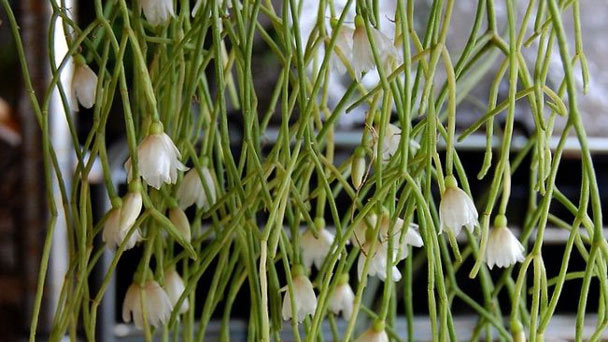
Rhipsalis Baccifera (Mistletoe Cactus) is found in parts of Central America, northern parts of South America, and the Caribbean. They are also inhabited in remote parts of Africa and Asia. Rhipsalis Baccifera is the largest and most widespread epiphytic cactus genus. Learn how to grow and care for the Rhipsalis Baccifera plant in this article.

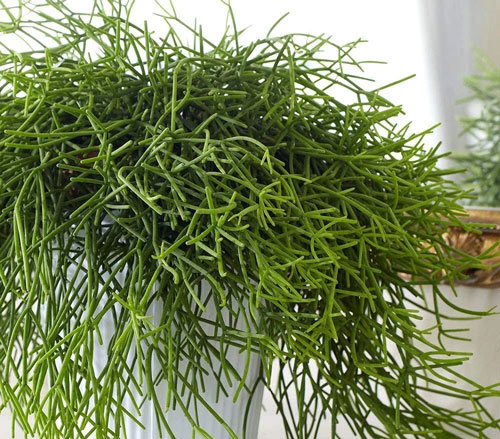
Select a pot with sufficient drainage and fill it with cactus soil or another free-draining compost.
Cut any part of a healthy stem (or one with a dry end that you want to get rid of!) and allow the end to dry for a few days before re-potting it into your cactus soil. Once potted, keep the top of the soil a little damp with a mister and keep the Rhipsalis Baccifera plant in a bright but indirect spot.
Rooting usually takes between 2-6 weeks but a gentle tug on the stem should help you to tell - if you feel resistance then the Rhipsalis Baccifera plant has a sufficient root base.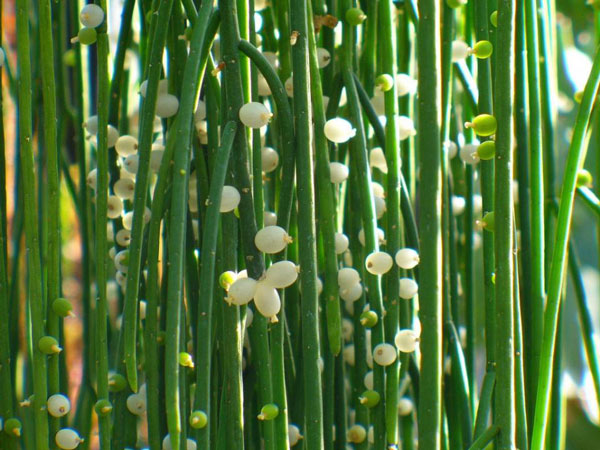
Rhipsalis Baccifera (Mistletoe Cactus) does not thrive well in direct sunlight and the afternoon sun can burn the leaves of the Rhipsalis Baccifera plant and turn them yellow. When the leaves turn pale, it means that the plant is not getting enough sunlight. Rhipsalis Baccifera requires a lot of filtered bright light. The morning sun is the best lighting condition for the Rhipsalis Baccifera. Rotate your plant time to time to ensure even growth on all sides.
1.always remove old and dead shoots
2.cut off long and disturbing shoots
3.can be cut into the desired shape without any problems
4.slightly poisonous sap, better wear gloves when pruning
Read more: Rhipsalis Baccifera: Grow & Care for Mistletoe Cactus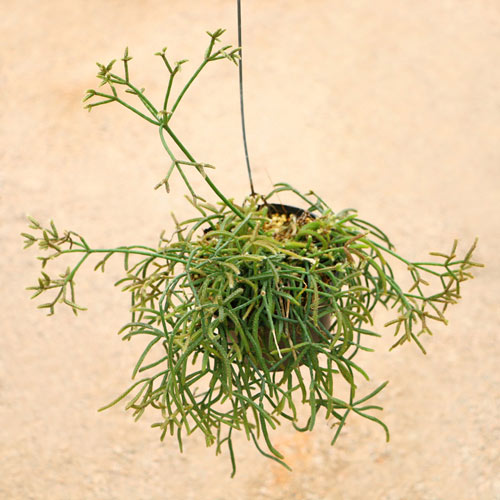
Because of its neutral colors, it goes beautifully with a number of different flowers.
If growing outdoors, add it to a shady spot like a porch as it will have ample space to grow and will not risk getting too much sun.
Rhipsalis Baccifera is also edible. It has medicinal properties which make it popular for certain remedies such as herbal paths or as a salve to help treat wounds.
The small, orb-like fruit the plant bears in spring is also edible and tastes juicy in a way similar to small grapes when eaten.
The most prominent genus is Rhipsalis, comprised of more than 40 species prized for their thin intertwining stems Most of these species are obscure tropical cacti that exist only in the rainforest and are never found in domestic cultivation. But some common Rhispalis species often grown as houseplants include:
Rhipsalis Baccifera(Mistletoe Cactus or spaghetti cactus) is characterized by long thread-like stems and creamy-white flowers that give way to mistletoe-like fruits. This plant forms hanging clusters that are typically 3 feet long or greater when mature. This is by far the most commonly grown cacti in the genus.
Rhipsalis cereuscula (coral cactus) is a shrubby or bushy plant with branhes up to 2 feet long. Many long cylindrical stems emerge from the ends of long slender branches that form hanging clusters and flowers with small, creamy-white blooms.
Rhipsalis clevata has a pendulous habit with many branches and white bell-shaped flowers. It makes a good hanging plant.
Rhipsalis pirocarpa is another tropical epiphytic from Brazil. It has long hairy cylindrical stems and fragrant white flowers about 3/4 in diameter. The shoots have reddish/purple edges, making this a very attractive species.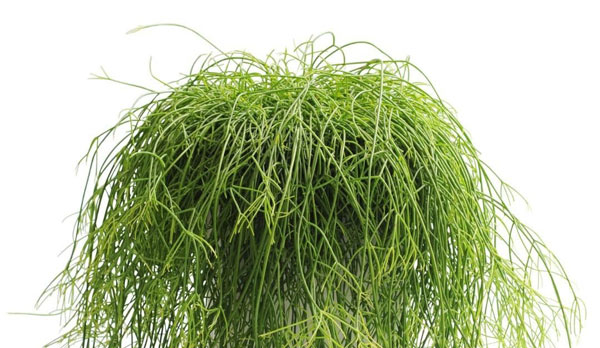
Rhipsalis Baccifera (Mistletoe Cactus) appear as white blobs or raised brown scales on the Rhipsalis Baccifera plant. You should remove them with tweezers and swab the area with alcohol to prevent future infestation.
Other pests such as spider mites or red spider mites are difficult to identify as they will become evident after making their first attack.
Get rid of them, spray your Rhipsalis Baccifera plant with Neem insecticide or a mix of systemic pesticides.
Upright and mounding forms of Rhipsalis Baccifera work well side-by-side with other indoor favorites, like split-leaf philodendron (Monstera deliciosa), staghorn fern (Platycerium bifurcatum) and pothos (Epipremnum aureum), and bring foliage diversity. Or double down on quirky forms by pairing a Mistletoe Cactus with look-alike, but more upright, milk bush (Euphorbia tirucalli).
Rhipsalis Baccifera (Mistletoe Cactus) PictureRhipsalis Baccifera (Mistletoe Cactus) InfoRhipsalis Baccifera (Mistletoe Cactus) Native HabitsRhipsalis Baccifera (Mistletoe Cactus) DistributionHow to Grow and Care for Rhipsalis Baccifera (Mistletoe Cactus)How to Grow Rhipsalis BacciferaHow to Care for Rhipsalis BacciferaUses of Rhipsalis Baccifera (Mistletoe Cactus)Varieties of RhipsalisRhipsalis Baccifera (Mistletoe Cactus) Common Pests/DiseasesRhipsalis Baccifera (Mistletoe Cactus) Companion Plants
Rhipsalis Baccifera (Mistletoe Cactus) Picture

Rhipsalis Baccifera (Mistletoe Cactus) Info
| Botanical Name | Rhipsalis Baccifera |
| Common Name | Mistletoe Cactus |
| Plant Type | llthophytic or epiphytic cacti |
| Mature Size | 1–20 feet (depends on species and age of plant) |
| Sun Exposure | Part shade to full shade |
| Soil Type | Porous cactus potting mix with organic matter |
| Soil pH | 5.0 to 6.5 (acidic) |
| Bloom Time | Year-round when grown in ideal conditions; varies by species. |
Rhipsalis Baccifera (Mistletoe Cactus) Native Habits
Rhipsalis Baccifera (Mistletoe Cactus) is also called chain cactus and grows epiphytically in its tropical forest home. The cactus has pencil-thin succulent stems that may reach 6 feet (2 m.) in length. The thick skin of the rhipsalis Baccifera stems do not produce thorns, but it does have almost imperceptible bumps on the surface of the plant. These Rhipsalis Baccifera plants are found clinging to tree crotches, in branch nooks, and nestled in rock crevasses. The rhipsalis baccifera (Mistletoe Cactus) is easy to grow and has very minimal needs. It is perfect for the home interior in a northern or western window.Rhipsalis Baccifera (Mistletoe Cactus) Distribution
Rhipsalis Baccifera (Mistletoe Cactus) is a tropical succulent that is native to the rainforests of Central and South America, Africa, and a couple of islands in the Indian Ocean. It's the only cactus to grow in the wild outside North and South America. There are some 60 different species, most of which grow on tree trunks. In the wild, they flower with many small white, yellow, orange, or red flowers, which produce berries when fertilized. This rarely happens in the home. Rhipsalis Baccifera's jungle background means that it's a houseplant with air-purifying properties according to research by NASA.
How to Grow and Care for Rhipsalis Baccifera (Mistletoe Cactus)
How to Grow Rhipsalis Baccifera
- With Seeds
- With Cuttings
Select a pot with sufficient drainage and fill it with cactus soil or another free-draining compost.
Cut any part of a healthy stem (or one with a dry end that you want to get rid of!) and allow the end to dry for a few days before re-potting it into your cactus soil. Once potted, keep the top of the soil a little damp with a mister and keep the Rhipsalis Baccifera plant in a bright but indirect spot.
Rooting usually takes between 2-6 weeks but a gentle tug on the stem should help you to tell - if you feel resistance then the Rhipsalis Baccifera plant has a sufficient root base.

How to Care for Rhipsalis Baccifera
- Light
Rhipsalis Baccifera (Mistletoe Cactus) does not thrive well in direct sunlight and the afternoon sun can burn the leaves of the Rhipsalis Baccifera plant and turn them yellow. When the leaves turn pale, it means that the plant is not getting enough sunlight. Rhipsalis Baccifera requires a lot of filtered bright light. The morning sun is the best lighting condition for the Rhipsalis Baccifera. Rotate your plant time to time to ensure even growth on all sides.
- Soil
- Water
- Fertilizer
- Pruning
1.always remove old and dead shoots
2.cut off long and disturbing shoots
3.can be cut into the desired shape without any problems
4.slightly poisonous sap, better wear gloves when pruning
Read more: Rhipsalis Baccifera: Grow & Care for Mistletoe Cactus

Uses of Rhipsalis Baccifera (Mistletoe Cactus)
Rhipsalis Baccifera is beautiful when grown as an ornamental, hanging accent plant. Rhipsalis Baccifera is best grown near large west or west-facing windows, or on a shaded porch. (Find more best indoor hanging plants here.)Because of its neutral colors, it goes beautifully with a number of different flowers.
If growing outdoors, add it to a shady spot like a porch as it will have ample space to grow and will not risk getting too much sun.
Rhipsalis Baccifera is also edible. It has medicinal properties which make it popular for certain remedies such as herbal paths or as a salve to help treat wounds.
The small, orb-like fruit the plant bears in spring is also edible and tastes juicy in a way similar to small grapes when eaten.
Varieties of Rhipsalis
The four genera within the Rhipsalideae tribe are Hatiora, Lepismium, Rhipsalis, and Schlumbergera.The most prominent genus is Rhipsalis, comprised of more than 40 species prized for their thin intertwining stems Most of these species are obscure tropical cacti that exist only in the rainforest and are never found in domestic cultivation. But some common Rhispalis species often grown as houseplants include:
Rhipsalis Baccifera(Mistletoe Cactus or spaghetti cactus) is characterized by long thread-like stems and creamy-white flowers that give way to mistletoe-like fruits. This plant forms hanging clusters that are typically 3 feet long or greater when mature. This is by far the most commonly grown cacti in the genus.
Rhipsalis cereuscula (coral cactus) is a shrubby or bushy plant with branhes up to 2 feet long. Many long cylindrical stems emerge from the ends of long slender branches that form hanging clusters and flowers with small, creamy-white blooms.
Rhipsalis clevata has a pendulous habit with many branches and white bell-shaped flowers. It makes a good hanging plant.
Rhipsalis pirocarpa is another tropical epiphytic from Brazil. It has long hairy cylindrical stems and fragrant white flowers about 3/4 in diameter. The shoots have reddish/purple edges, making this a very attractive species.

Rhipsalis Baccifera (Mistletoe Cactus) Common Pests/Diseases
Rhipsalis Baccifera (Mistletoe Cactus) can experience a few pests. Mealybugs and scale insects are easy enough to get rid of and prevent.Rhipsalis Baccifera (Mistletoe Cactus) appear as white blobs or raised brown scales on the Rhipsalis Baccifera plant. You should remove them with tweezers and swab the area with alcohol to prevent future infestation.
Other pests such as spider mites or red spider mites are difficult to identify as they will become evident after making their first attack.
Get rid of them, spray your Rhipsalis Baccifera plant with Neem insecticide or a mix of systemic pesticides.
Rhipsalis Baccifera (Mistletoe Cactus) Companion Plants
Show off the form of trailing varieties, like Rhipsalis Baccifera and R. burchellii, by planting them in hanging baskets or hanging macrame planters. Position Rhipsalis Baccifera plants where the tendrils will have plenty of room to trail — some reach up to 6 feet long.Upright and mounding forms of Rhipsalis Baccifera work well side-by-side with other indoor favorites, like split-leaf philodendron (Monstera deliciosa), staghorn fern (Platycerium bifurcatum) and pothos (Epipremnum aureum), and bring foliage diversity. Or double down on quirky forms by pairing a Mistletoe Cactus with look-alike, but more upright, milk bush (Euphorbia tirucalli).
Latest Updated
- Benefits of Bugleweed - 7 Science-backed Health Benefits
- Bugleweed Dangers & Side Effects - Is It Poisonous?
- How to Plant Evergreen Trees - What You Should Know
- When to Plant Evergreens - Grow Guide for Evergreen Trees
- 12 Wonderful Evergreen Shrubs for Your Garden
- 12 Popular Evergreen Plants with Pictures for Beginners
- When And How To Prune A Lilac Bush Like a Pro
- How to Grow & Care for Lilac Vine (Hardenbergia Violacea)
- Japanese Lilac Tree (Syringa Reticulata) Care & Propagation Guide
- Shumard Oak Pros and Cons - What to Know
Popular Articles
- Winter maintenance of Antirrhinum Majus
- How to Grow Terminalia Mantaly Tree
- How to Grow and Care for Crossostephium Chinense
- How to grow Antirrhinum Majus in spring
- Peristeria Elata (Dove Orchid) Profile: Info & Care Guide
- Underwatered Snake Plant (Sansevieria Trifasciata) - Signs And How To Fix
- How to Care for Brazilian Jasmine Plant (Mandevilla Sanderi)
- How to Grow & Care for Graptopetalum Purple Delight in Summer
- Rosa Chinensis (China Rose): Plant Growing & Care Tips
- How to Care for Baby Sun Rose (Aptenia Cordifolia)